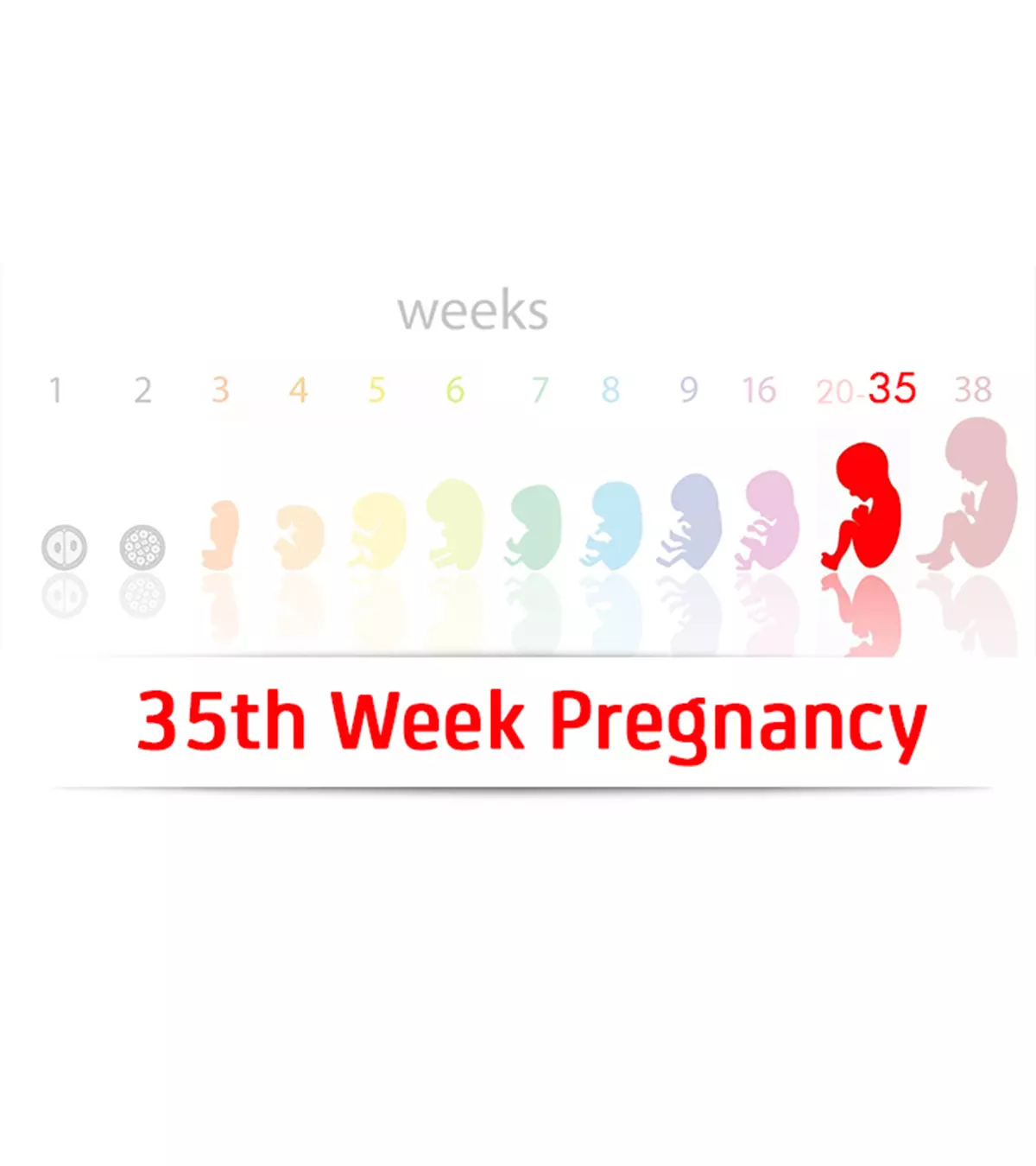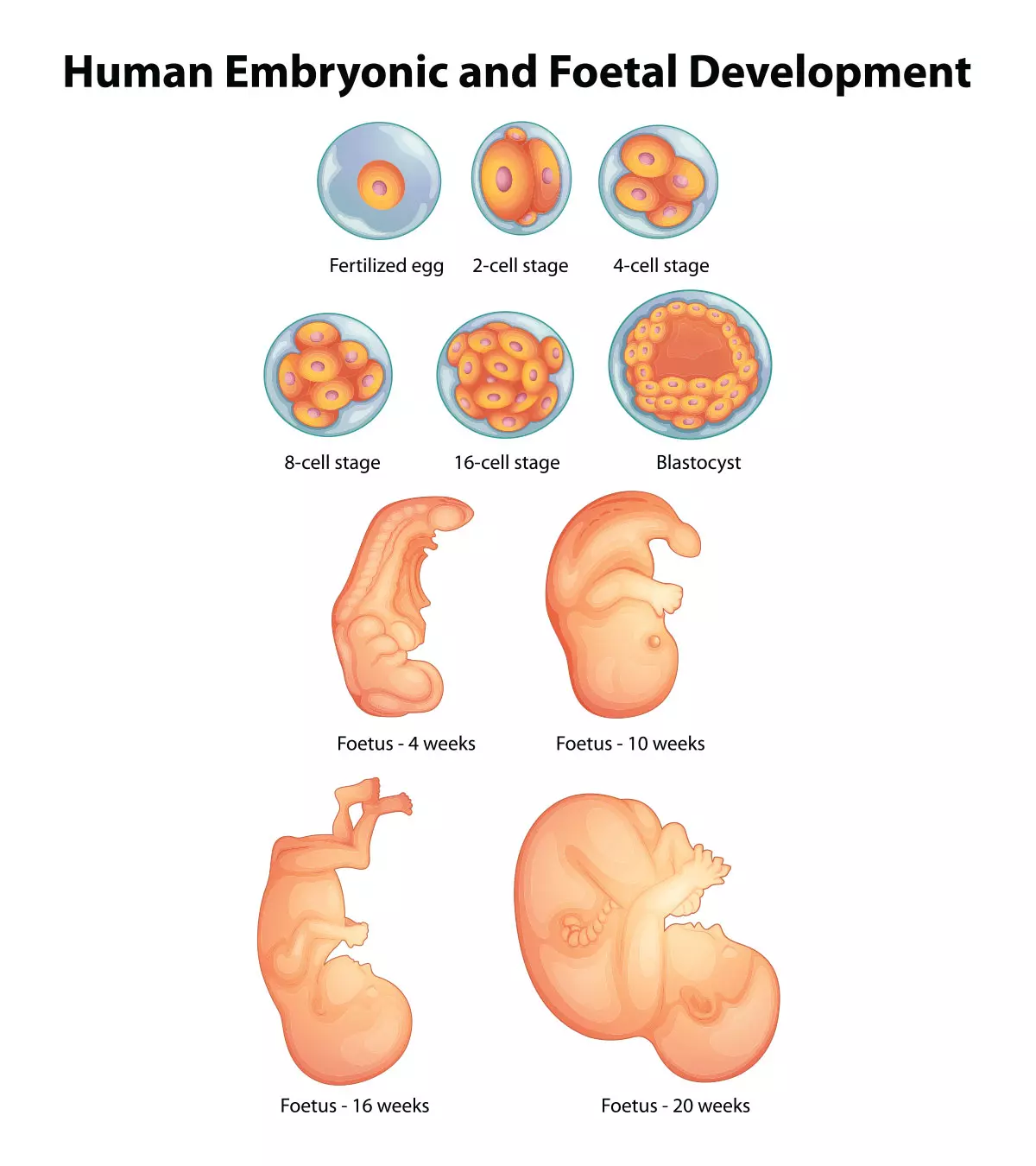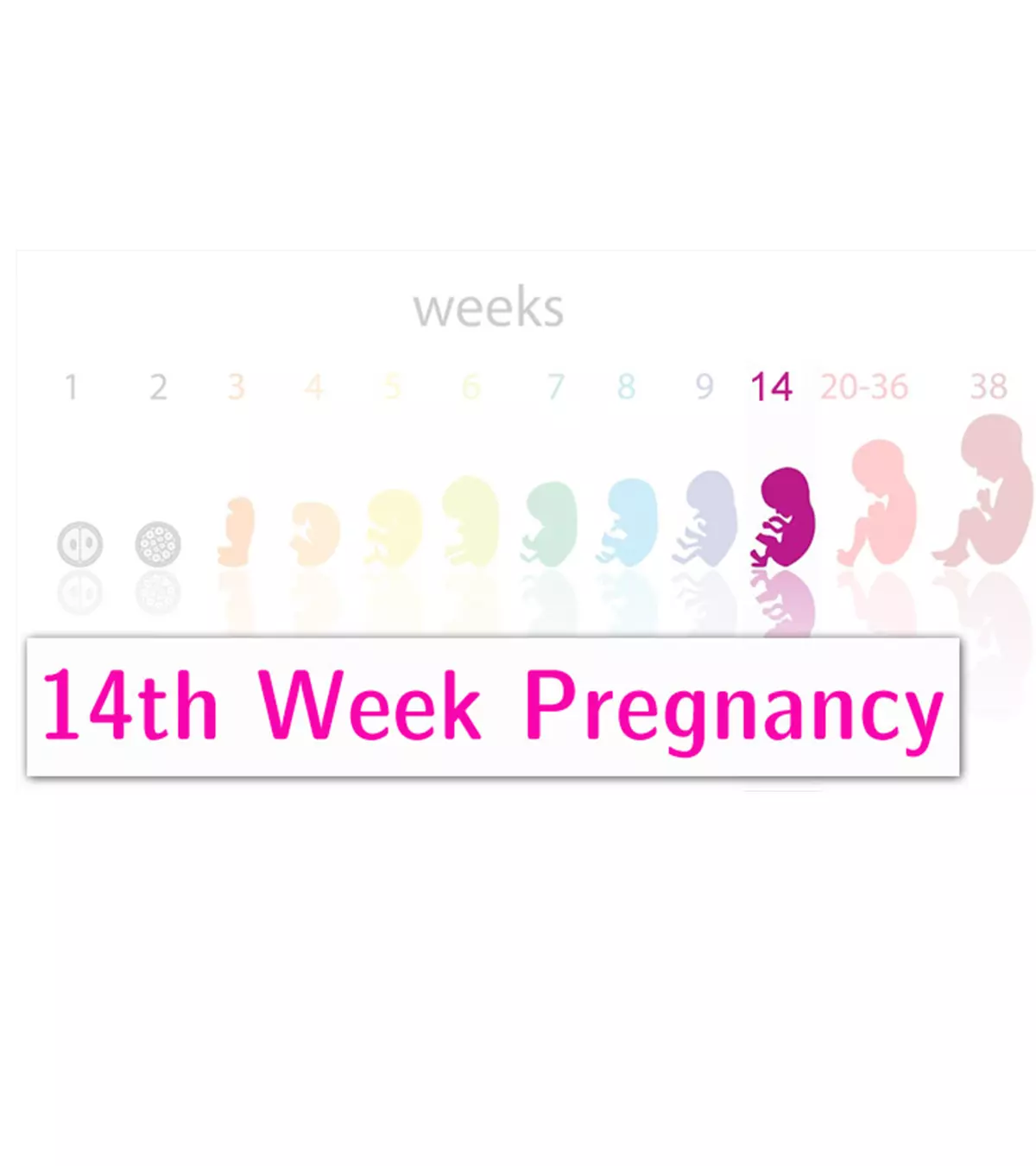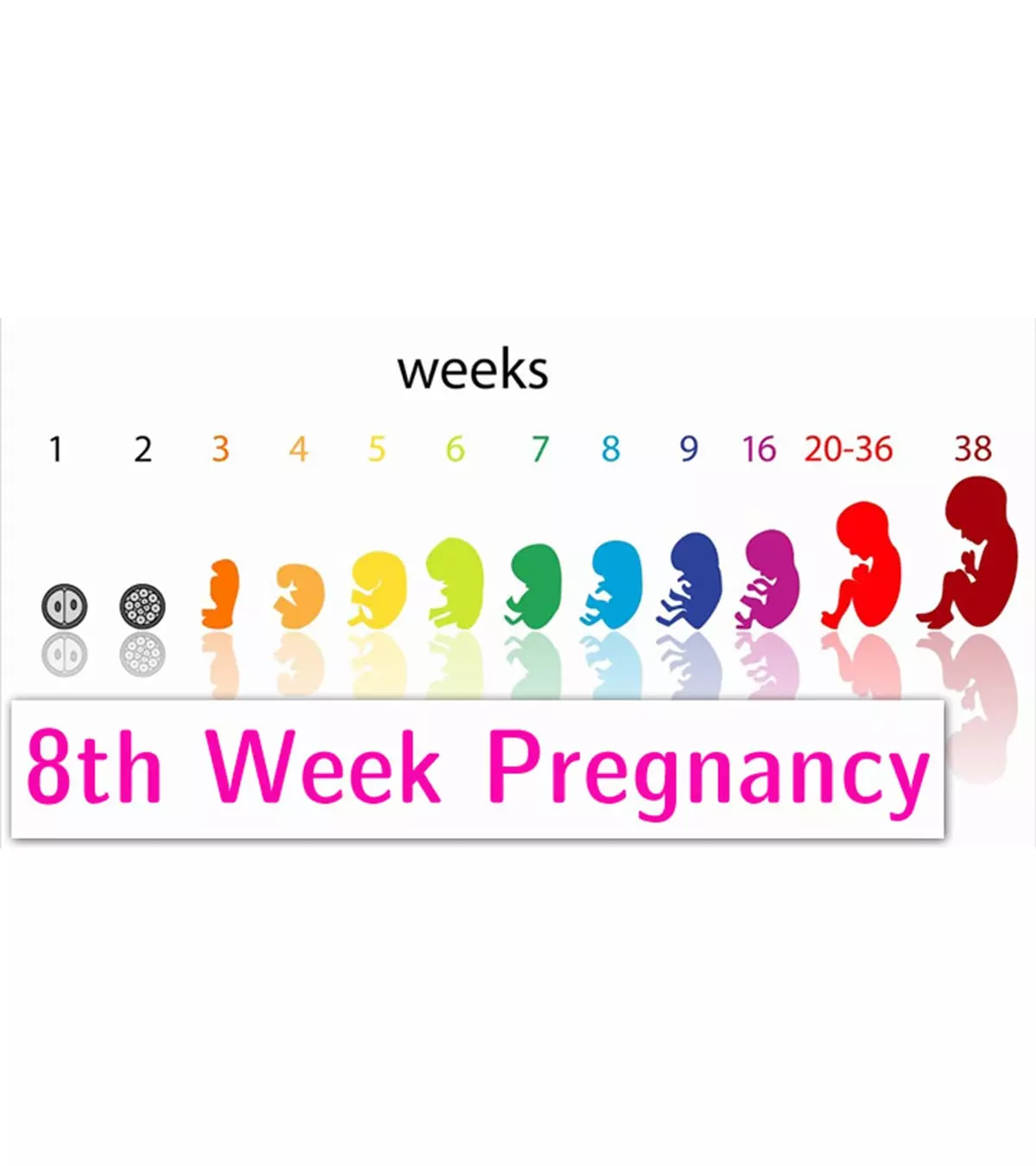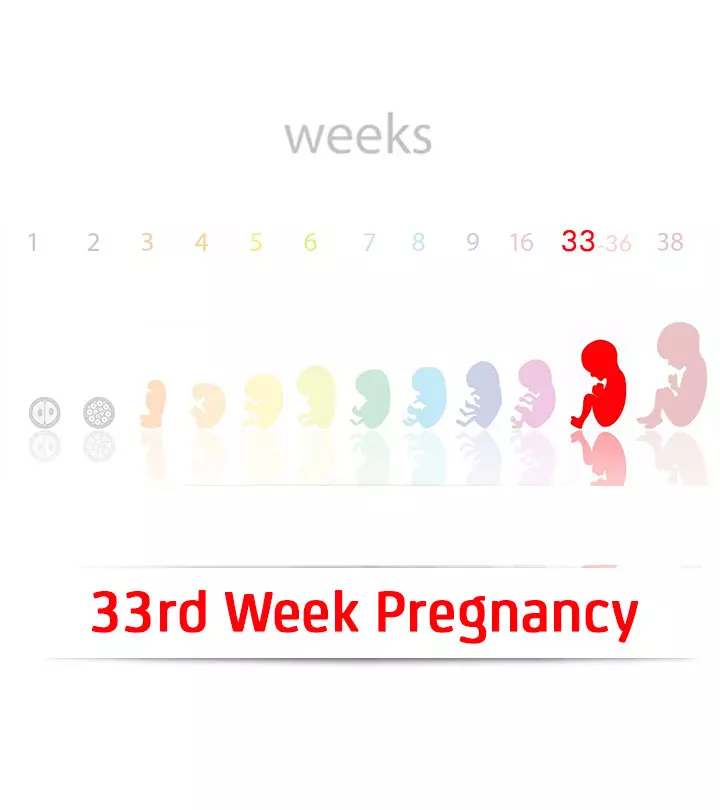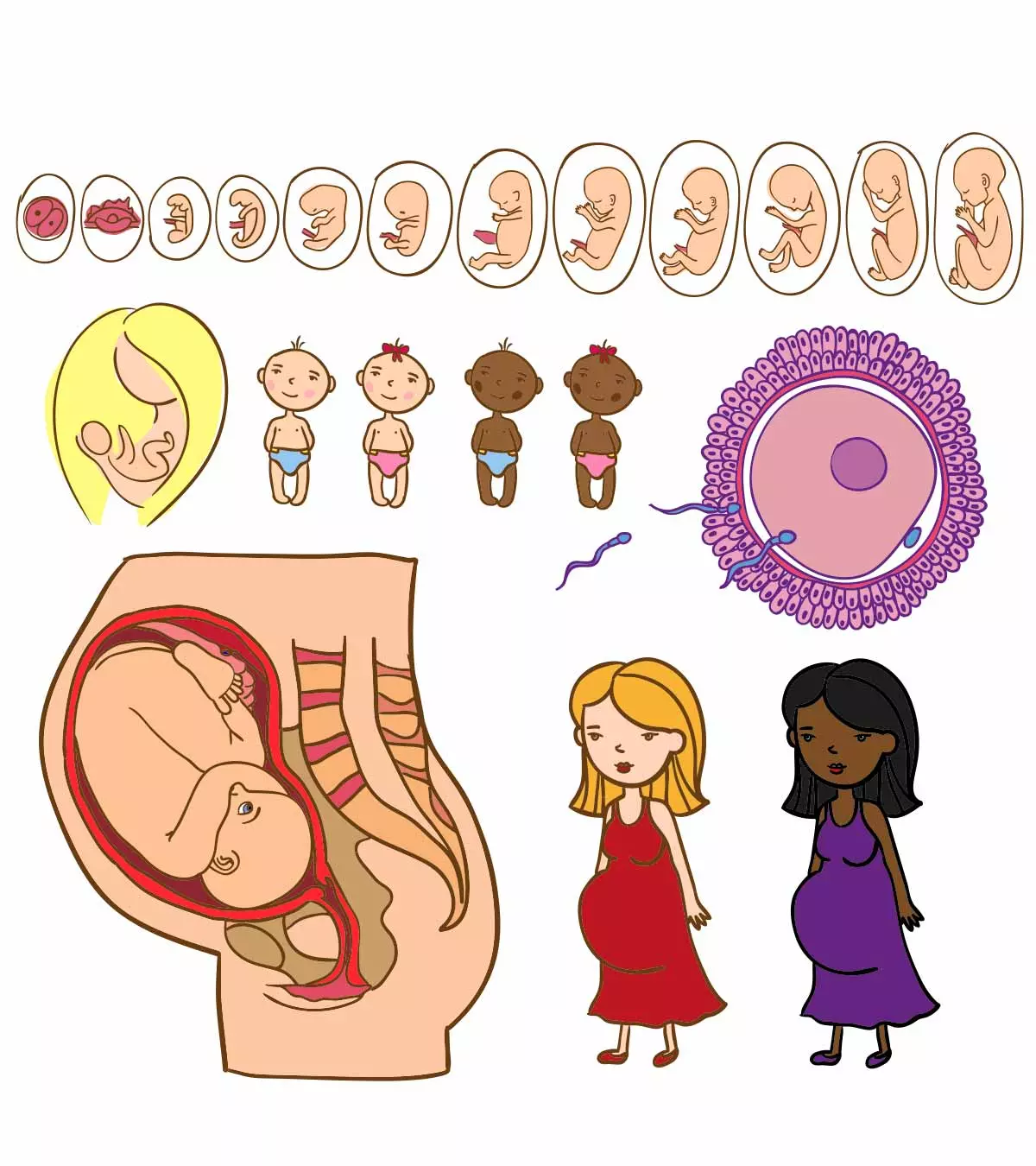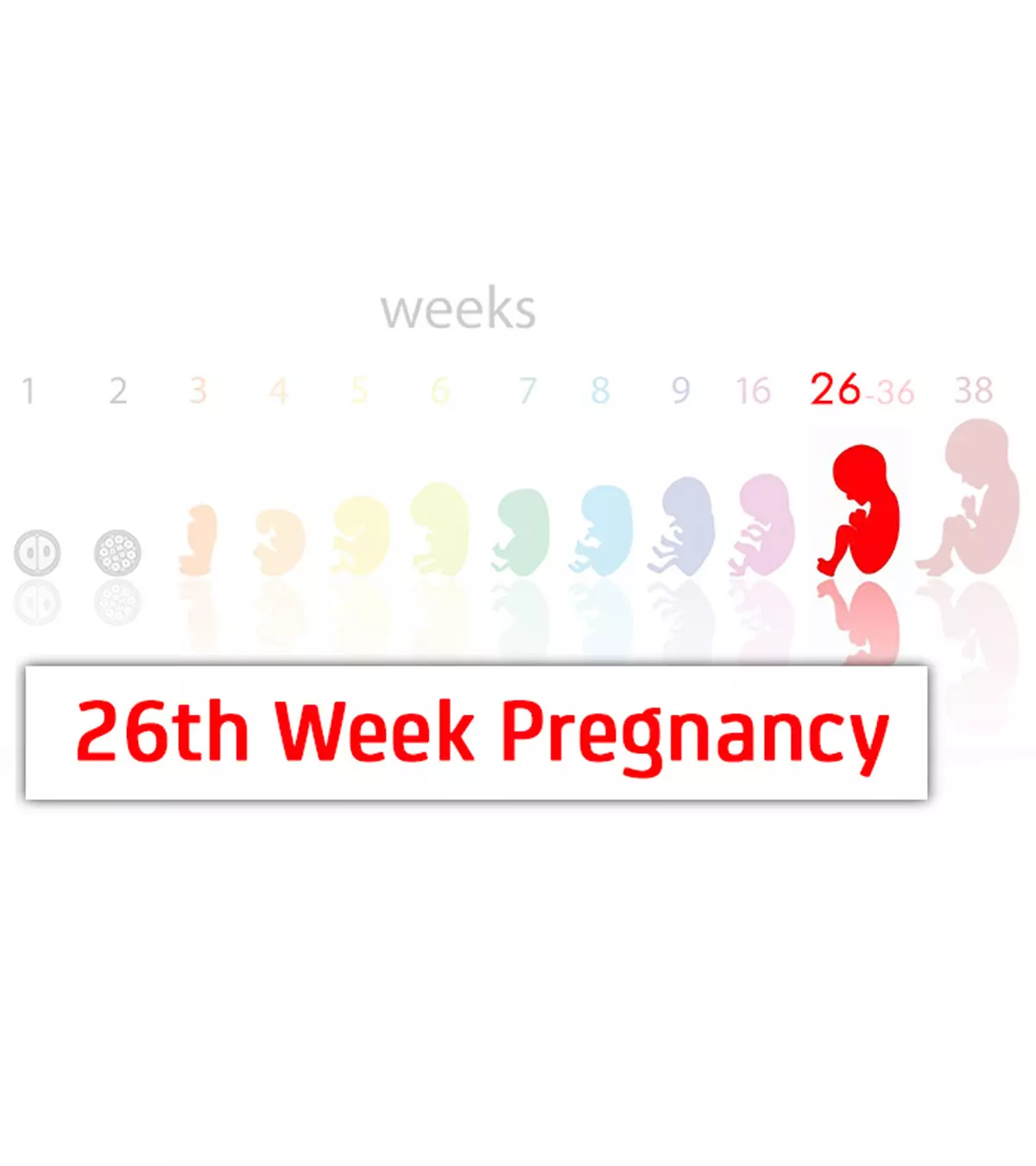
Image: MomJunction Design Team
If you are 6 months pregnant, you are in the final month of your second trimester and only three months away from giving birth to your baby. Your baby bump has enlarged by this month, and you have a clear pregnancy radiance on your face. Your baby is growing quickly, and so your body is changing dramatically in preparation for childbirth.
This post informs you about the various changes in your body at six months of gestationiThe period between conceiving and giving birth , the baby’s development, and potential pregnancy complications, as well as the precautions you should take during this month.
Key Pointers
- The second trimester ends at six months into pregnancy, leaving three more months until delivery.
- Physical changes during this period include stretch marks, linea nigra, skin color changes, and breast colostrum leaks.
- Emotional changes may also occur, such as pregnancy brain, forgetfulness, and absentmindedness.
- The baby’s body is undergoing rapid development and changes during this time.
- Hormone levels may cause heartburn and constipation as common symptoms during pregnancy.
What Are The Symptoms Of Pregnancy In The Sixth Month?
, MD, a former clinical associate professor at the University of North Dakota, says, “At six months of gestation, you would be approximately two-thirds through your pregnancy. Your baby has a reasonable chance of surviving in good condition. Twenty-five years ago, I delivered quadruplets at about that gestational age. All four babies weighed 1.5 pounds, give or take a few ounces. They all did well and have now reached healthy adulthood.”
You may experience the 6th month pregnancy symptoms such as (1) (2) (3):
- Weight gain: You may gain 3 to 4 pounds by this month (4).
- Fatigue: The body is working more to nourish your baby, which makes you feel tired, although not as much as before.
- Constipation: The pregnancy hormones relax the intestinal muscles. Also, the pressure of the growing uterus on the intestine slows the movement of food, leading to constipation.
- Heartburn: The gastrointestinal tract relaxes due to the increased progesteroneiA hormone produced by the female reproductive system, crucial for maintaining a regular menstrual cycle and pregnancy levels. The upward pressure that the uterus exerts on the stomach pushes the gastric juices into the esophagus, causing a burning sensation.
- Flatulence (gas): As the progesterone hormone relaxes the intestinal muscles, the digestion process slows down and builds up gas.
- Nasal congestion: An increase in the estrogeniA sex hormone linked to the female reproductive system and helps maintain sexual traits, menstruation, and pregnancy hormone results in swelling of the nasal passage lining, making way for more mucus and causing congestion.
- Nosebleeds: An increase in the blood circulation during pregnancy expands the small blood vessels in the nose. The pressure exerted on the blood vessels can lead to nosebleeds.

- Bleeding gums: An increase in the blood flow and hormonal changes are the reason for swollen and bleeding gums during pregnancy.
- Increased appetite: As the morning sickness is minimal by 6 months of pregnancy, there is an elevation in food cravings. Cravings are normal and a reasonable increase in food intake necessary to meet the demands of the growing baby.
- Swollen ankles: The water retention in the body and the pressure put by the growing uterus on the veins, restricting the backflow of the blood, leads to edema or swollen ankles.
- Achy feet: The edema, as well as the pregnancy weight gain, put additional pressure on the feet, causing the feet to ache.
- Varicose veins: The pressure exerted by the growing uterus on the inferior vena cava (the largest vein in the body that carries blood from legs to heart) restricts the blood flow, causing the veins near the legs to swell.
- White vaginal discharge: The cervix and the vaginal walls soften during pregnancy causing white discharge, which in turn prevents any bacteria from traveling to the uterus through the vagina.
- Breathlessness: The growing uterus puts pressure on the diaphragmiA thin muscle layer below the lungs and heart, separating the chest area from the abdominal cavity and aiding breathing , which may cause breathlessness.
- Backache: The uterus also puts pressure on your lower back. Also, pregnancy results in the stretching of the joint ligaments in the pelvic and lower back area. Both these factors lead to backache.
- InsomniaiA sleep disorder that makes it difficult for a person to fall asleep and stay asleep : Frequent visits to the bathroom, backache, nasal congestion, etc. can deprive you of a good night’s sleep.
- Braxton Hicks contractions: Some women may feel painless contractions, which is normal and a way to prepare the body for delivery. It may come more often as you get closer to your due date.
Lisa Murphy, a six-month pregnant woman, shares how she experiences palpitations and breathlessness. She says, “I mentioned briefly in my last update about the palpitations I’ve been getting, well they are only getting worse and more frequent! I could be sitting down chilling on the sofa, and they could come on me just like that. I get shortness of breath, my heart races, sometimes the room spins, and I could get dizzy. My doctor told me that the baby is completely unaware of what’s happening when I’m getting them. Which made me very relieved just to know that he was okay and nothing was wrong with him. It’s just something I have to put up with and suffer through for the remainder of the pregnancy. I have been getting used to them, and since getting checked out by my doctor, my anxiety has calmed down a lot (i).”
 Did you know?
Did you know?Physical Changes In The Sixth Month
The physical changes that you may experience include:
- Stretch marks: The growing uterus causes tiny tears in the skin tissues, causing stretch marks.
- Linea nigra: The line running down from the belly button to the pubis becomes darker.
- Skin pigmentation changes: Production of more hormones during pregnancy can lead to skin pigmentation, also known as melasma. It appears as darkened spots near the cheeks, neck, and the forehead.
- Colostrum: The breast may start leaking a yellowish liquid called colostrum, which is the first breast milk that your baby will feed on immediately after delivery.
Emotional Changes In The Sixth Month
Here are a few emotional changes you might experience:
- Pregnancy brain: The inability to concentrate (absent-mindedness) or forgetfulness is all attributed to the hormonal changes during pregnancy. It is sometimes also referred to as momnesia.
 Expert says
Expert says
- Mood swings and anxiety: These happen due to hormonal changes during pregnancy.
Managing stress during pregnancy is essential, as high stress levels can impact your health and your baby’s development. Pregnancy-safe practices, including prenatal yoga, meditation, and deep-breathing exercises, may be effective in reducing stress.
Baby Developments In The Sixth Month Of Pregnancy
Dr. Lindemann adds, “At six months, the baby has developed arms, hands with ten fingers, legs with feet and ten toes, and good reflexes. The baby has eyes and eyelids so she or he can see, ears to hear, lips, nose, tongue, neck, and a heart that works. However, the baby’s lungs don’t work very well.”
The weeks from 21-24 constitute the sixth month. During these weeks, your baby grows from the size of a carrot to as big as the ear of corn (5). The baby attains a human face by now.
Baby weight: 8 ounces to 1 pound
Baby’s CRL (crown-rump length): It is about 8-12in (20-30cm)
Your baby’s growth spurts during this month. Here is how your little one’s body is developing this month (3), (6) (2) (7).
| Body Part | Development |
|---|---|
| Skin | Fat is depositing under the skin. |
| Genitals | Boys: Testicles begin to move from abdomen to scrotum. Girls: Uterus and ovaries are in place with a lifetime supply of eggs. |
| Lungs | Develop surfactants that are necessary for primitive gas exchanges. Terminal sacs, which later develop into alveoli, appear. |
| Brain | Brain weight increases between 400 and 500%. More than 50% of the energy used by the baby is utilized for brain development. |
| Bone marrow | Starts making blood cells. |
| Taste buds | Begin to form. |
| Eyes | Eyebrows and eyelashes start developing. |
| Head | Proportional to the size of the body. |
| Hair and nails | Start to grow. |
| Teeth buds | Forming under the gum. |
| Lanugo | Covers the entire body. |
| Meconium | Intestine starts making it, which becomes the first bowel. |
Baby’s Position And Movements In The Sixth Month
Position:
During this month, there is more space inside the womb for the baby to move freely and attain various positions.
Movements:
By this time, fetal movement is quite noticeable as you can feel the baby wiggle and roll inside. The baby’s kicks are strong, and a sleeping pattern is established.
During pregnancy you need to be careful with the food that you eat. Your plate should comprise nutritious foods in the right proportion.
Pregnancy Diet To Follow During the Sixth Month

Ensure your diet is balanced and includes a range of foods to meet your nutritional needs and your baby’s. A healthy diet can help control weight gain and support your baby’s growth and development. Here is the list of foods that you may add to your 6th month of pregnancy diet (8):
- Consume plenty of green leafy vegetables, bread, fortified cereals, and milk. These are rich sources of calcium. The American College of Obstetricians and Gynecologists (ACOG) recommends a daily intake 1,000mg calcium during pregnancy.
- Foods like lentils, leafy vegetables (spinach, romaine lettuce, broccoli, and kale), kidney beans, nuts, beans, and citrus fruits are rich sources of folic acid. The ACOG recommends a daily intake of 400mcg of folic acid during pregnancy.
- Eat whole grain products, beans, dried fruit, lean pork and beef, green leafy vegetables and sardines, which are a good source of iron. The daily recommended intake of iron is 27mg per day (including the supplement).
- Foods such as yellow or orange vegetables (sweet potatoes or carrots), leafy green vegetables, liver, and milk that are rich in vitamin A must be added to your diet. The recommended daily intake is 770mcg.
- Fatty fish like salmon and milk fortified with vitamin D help you reach the recommended vitamin D intake of 600IU per day. But avoid sea fish.
- According to the ACOG, the average daily intake of DHA by a pregnant woman is 200mg, which can be procured from dry fruits and fortified heath drinks and supplements.
- Include lean meat and poultry, (risk of mercury poisoning in sea fish) eggs, soy products, peas and beans, and unsalted seeds and nuts that are a rich source of protein.
- Add citrus fruits, strawberries, tomatoes, and broccoli to your diet. They are a good source of vitamin C. The average daily recommended intake is 85mg.
Foods To Avoid During The Sixth Month Of Pregnancy
Here is the list of foods you need to avoid:
- Avoid too much caffeine (more than 200-300 mg/day) (9).
- Do not eat raw or uncooked food, as it can cause listeriosis (a food-borne bacterial infection) (10). The U.S. Food and Drug Administration states that pregnant women are ten times more susceptible to listeria infections than other individuals. Therefore, to minimize the risk of such infections, you should refrain from consuming raw foods and instead opt for fresh, healthy, and home-cooked food options while pregnant.
- Those who have celiac disease should avoid foods that contain gluten (11). Instead, they may opt for fruits, vegetables, beans, potato, meat, and poultry.
- Avoid swordfish, shark, tilefish, and king mackerel that contain a high level of mercury.
- Limit the consumption of deep-fried and spicy foods as it can cause heartburn.
- Avoid unpasteurized milk and cheese.
 Quick tip
Quick tipBesides good home care to stay healthy, it is important that you go for your monthly check-up without fail.
What To Expect During Your Visit To The Ob/Gyn?
During the visit to the doctor, you will undergo:
Physical examination
- Blood pressure check
- Weight check
- Measurement of fundal height
Other tests
- Glucose tolerance test for checking gestational diabetes. During the test, you will have to drink a sugary syrup. An hour later, a blood sample will be taken to check the glucose levels in your blood (12).

- Ultrasound will help monitor the fetal development. The doctor will check for the baby’s weight and CRL. They also monitor the functioning of the internal organs. Level II scan or anomaly scanning is done around 20 weeks.
Next, we tell you about a few things you must be aware of to prevent any unwanted instances.
What Do You Need to Know in Your Sixth Month of Pregnancy?
Here are some symptoms that you must watch out for during pregnancy (13):
- Belly or pelvic pain, other than mild cramping
- Vaginal bleeding
- Fever of 100.4°F or higher
- Painful or less urination
- Dark-colored urine
- Vomiting that gets worse and lasts longer than 24 hours
- Feel like you might pass out
- Headaches that do not subside even after taking acetaminophen (Tylenol)
- Uncontrollable nosebleed
- Constant leg cramps
Preterm labor is one of the risks you should be wary of this month. If you experience any of the following symptoms, then get medical help immediately (14):
- Experiencing more than five contractions in an hour or every 10 minutes.
- Vaginal fluid leak
- Pelvic pressure
- Menstrual-like cramps
- Any vaginal bleeding
- Abdominal cramps with or without diarrhea
- A dull, low backache
- A sudden increase in vaginal discharge
The best way to take care of your health is to follow a good lifestyle, which will take care of the rest of the things.
Precautions To Be Taken In The Sixth Month
Here are some precautionary measures you should follow this month:
- Keep your stress at bay.
- Drink plenty of fluids to keep yourself hydrated.
- Avoid smoking and drinking alcohol.

- Get enough rest.
- Take prenatal vitamins without fail
- Maintain oral hygiene.
- Walking and doing Kegel exercises can strengthen the pelvic muscles.
- Do not lift any heavy objects.
- Wear comfortable, flat footwear and loose, breathable maternity clothes.
- Avoid taking any medicine without the doctor’s advice.
- Avoid cleaning cat litter as it can cause toxoplasmosis.
- Avoid exposure to chemicals.
At this time, you could be going through a lot of mood swings and even have difficulty in managing household things. Your partner can help you with the chores and also make you feel comfortable now.
Tips For Dad-to-be
- Help you with the household chores.
- Spend some quality time with you, preparing to welcome the new member.
- Accompany you to the doctor’s appointments, walks, and shopping trips.
Frequently Asked Questions
1. Can I have a 4D ultrasound in six months of pregnancy?
Yes, it is safe to have a 4D ultrasound during the sixth month of pregnancy, typically around week 24. This can provide a detailed and lovely image of your growing baby (15).
2. Can I have contractions at six months pregnant?
Yes, you can experience Braxton-Hicks contractions during the sixth month of pregnancy. These are normal and indicate that the uterus is preparing for labor and delivery. Although they may feel like real contractions, they are painless and do not signal the start of labor (16).
3. How do babies develop in twin pregnancies at six months?
Dr. Lindemann opines, “There are different types of twin gestations based on the number of placentas and the existence of membranes between the twins. Without a separating membrane, the twins have problems getting their umbilical cords twisted. There are often discrepancies in size with one twin growing larger than the other twin, probably because it gets more nutrition.”
“However, most twins contain a membrane between babies so that cords can’t get mixed up and they have their own nutrition. When this happens, twins have a reasonable chance of growing normally and being born relatively at term, for example at 39 weeks.”
Your adorable baby bump is very noticeable when you are 6 months pregnant. As you are ready to step into the third trimester of pregnancy, you may start experiencing subtle changes in your body as your uterus continues to expand. You could also have skin and emotional changes, which may persist in the proceeding months. However, you should take good care of yourself for the next three months to have a smooth delivery. So, avoid stressing out, pamper yourself with delectable yet healthy foods and hang out with your friends and family to enjoy this phase.
Infographic: What Are The Symptoms Of Pregnancy In The Sixth Month?
During the sixth month of pregnancy, a woman may experience a wide range of symptoms. The following infographic lists some of the common ones to look out for. Expectant mothers need to maintain a healthy diet, stay hydrated, keep up with regular exercise, and get sufficient rest. If you have any concerns about your symptoms, it is always best to consult your doctor. Illustration: Momjunction Design Team
Illustration: 6 Months Pregnant: Symptoms Baby Development And Diet Tips

Image: Stable Diffusion/MomJunction Design Team
Personal Experience: Source
MomJunction articles include first-hand experiences to provide you with better insights through real-life narratives. Here are the sources of personal accounts referenced in this article.
i. 6 month pregnancy update.https://cuddlesandcontouring.blogspot.com/2015/04/6-month-pregnancy-update.html
References
1. Back pain in pregnancy, NHS
2. What happens in the sixth month of pregnancy?, Planned Parenthood Federation of America Inc. (2019)
3. Stages of pregnancy, Office on women’s health
4. Second Trimester Overview, Sutter Health (2024)
5. Week by Week Fetus Size Demonstrated by Fruits, EPAOA (2014-2019)
6. Prenatal Form and Function – The Making of an Earth Suit, The Endowment For Human Development, Inc. (2001-2019)
7. Fetal development, NIH (2019)
8. Nutrition During Pregnancy, ACOG pdf.
9. Pregnancy Precautions: FAQs, The Nemours Foundation (1995-2019)
10. Listeria Infection (Listeriosis), Organization of Teratology information Specialist
11. How Celiac Disease Affects Pregnancy, Celiac Disease Foundation (1998-2018)
12. Prenatal Tests: Second Trimester, The Nemours Foundation (1995-2019)
13. When to call us, Kaiser Foundation Health Plan, Inc (2018)
14. Premature Labor, Sutter Health (2024)
15. Why to avoid ‘keepsake’ 3-D and 4-D ultrasounds, UT Southwestern Medical Center
16. What happens in the sixth month of pregnancy?, Planned Parenthood
17. Pregnancy Constipation; Cleveland Clinic
18. Constipation during pregnancy; Pregnancy, Birth and Baby
19. Braxton Hicks Contractions; National Library Of Medicine
20. Is ‘pregnancy brain’ real or just a myth?; UT Southwestern Medical Center
21. Foods to Avoid When Pregnant; American Pregnancy Association
Community Experiences
Join the conversation and become a part of our nurturing community! Share your stories, experiences, and insights to connect with fellow parents.
Read full bio of Dr. Richa Hatila Singh
- Dr. Alan Lindemann is an obstetrician and maternal mortality expert, who worked as a clinical associate professor at the University of ND. An alumnus of the University of ND and the University of Minnesota, he is a member of the American College of Obstetricians and Gynecologists and the American Medical Association.
 Dr. Alan Lindemann is an obstetrician and maternal mortality expert, who worked as a clinical associate professor at the University of ND. An alumnus of the University of ND and the University of Minnesota, he is a member of the American College of Obstetricians and Gynecologists and the American Medical Association.
Dr. Alan Lindemann is an obstetrician and maternal mortality expert, who worked as a clinical associate professor at the University of ND. An alumnus of the University of ND and the University of Minnesota, he is a member of the American College of Obstetricians and Gynecologists and the American Medical Association.
Read full bio of shreeja pillai
Read full bio of Rebecca Malachi
Read full bio of Aneesha Amonz





 Quick fact
Quick fact




